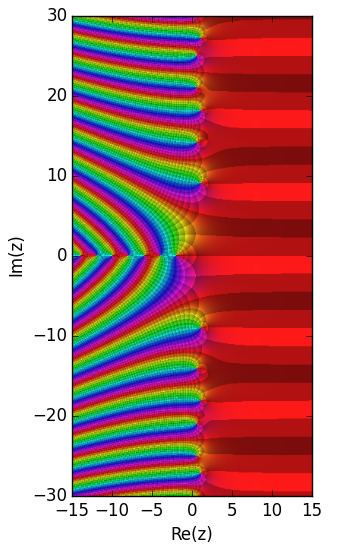 | ||
In mathematics, in the area of analytic number theory, the Dirichlet eta function is defined by the following Dirichlet series, which converges for any complex number having real part > 0:
Contents
- Zeros
- Landaus problem with s s0 and solutions
- Integral representations
- Numerical algorithms
- Borweins method
- Particular values
- Derivatives
- References
This Dirichlet series is the alternating sum corresponding to the Dirichlet series expansion of the Riemann zeta function, ζ(s) — and for this reason the Dirichlet eta function is also known as the alternating zeta function, also denoted ζ*(s). The following relation holds:
While the Dirichlet series expansion for the eta function is convergent only for any complex number s with real part > 0, it is Abel summable for any complex number. This serves to define the eta function as an entire function (and the above relation then shows the zeta function is meromorphic with a simple pole at s = 1, and perhaps poles at the other zeros of the factor
Equivalently, we may begin by defining
which is also defined in the region of positive real part (
Hardy gave a simple proof of the functional equation for the eta function, which is
From this, one immediately has the functional equation of the zeta function also, as well as another means to extend the definition of eta to the entire complex plane.
Zeros
The zeros of the eta function include all the zeros of the zeta function: the infinity of negative even integers (real equidistant simple zeros); an infinity of zeros along the critical line, none of which are known to be multiple and over 40% of which have been proven to be simple, and the hypothetical zeros in the critical strip but not on the critical line, which if they do exist must occur at the vertices of rectangles symmetrical around the x-axis and the critical line and whose multiplicity is unknown. In addition, the factor
Under the Riemann hypothesis, the zeros of the eta function would be located symmetrically with respect to the real axis on two parallel lines
Landau's problem with ζ(s) = η(s)/0 and solutions
In the equation η(s) = (1−21−s) ζ(s), "the pole of ζ(s) at s=1 is cancelled by the zero of the other factor" (Titchmarsh, 1986, p. 17), and as a result η(1) is neither infinite nor zero. However, in the equation
η must be zero at all the points
A first solution for Landau's problem was published almost 40 years later by D. V. Widder in his book The Laplace Transform. It uses the next prime 3 instead of 2 to define a Dirichlet series similar to the eta function, which we will call the
An elementary direct and
Assuming
The apparent singularity of zeta at
Integral representations
A number of integral formulas involving the eta function can be listed. The first one follows from a change of variable of the integral representation of the Gamma function (Abel, 1823), giving a Mellin transform which can be expressed in different ways as a double integral (Sondow, 2005). This is valid for
The Cauchy–Schlömilch transformation (Amdeberhan, Moll et al., 2010) can be used to prove this other representation, valid for
The next formula, due to Lindelöf (1905), is valid over the whole complex plane, when the principal value is taken for the logarithm implicit in the exponential.
This corresponds to a Jensen (1895) formula for the entire function
"This formula, remarquable by its simplicity, can be proven easily with the help of Cauchy's theorem, so important for the summation of series" wrote Jensen (1895). Similarly by converting the integration paths to contour integrals one can obtain other formulas for the eta function, such as this generalisation (Milgram, 2013) valid for
The zeros on the negative real axis are factored out cleanly by making
Numerical algorithms
Most of the series acceleration techniques developed for alternating series can be profitably applied to the evaluation of the eta function. One particularly simple, yet reasonable method is to apply Euler's transformation of alternating series, to obtain
Note that the second, inside summation is a forward difference.
Borwein's method
Peter Borwein used approximations involving Chebyshev polynomials to produce a method for efficient evaluation of the eta function. If
then
where for
The factor of
Particular values
Also:
The general form for even positive integers is:
Derivatives
The derivative with respect to the parameter s is for
